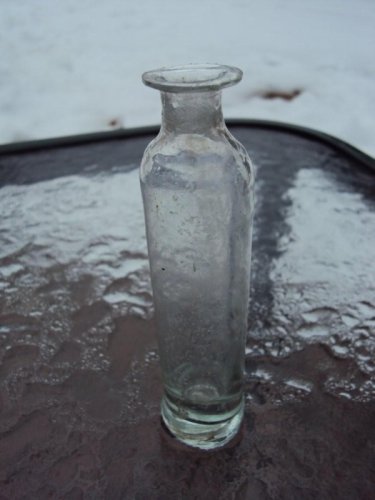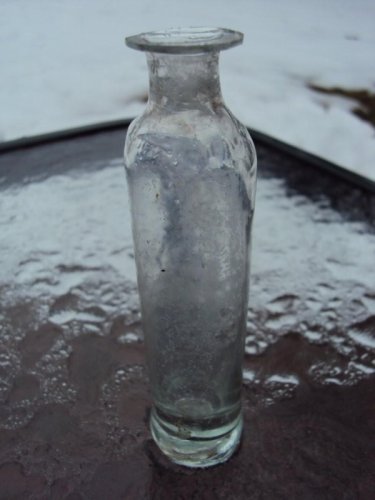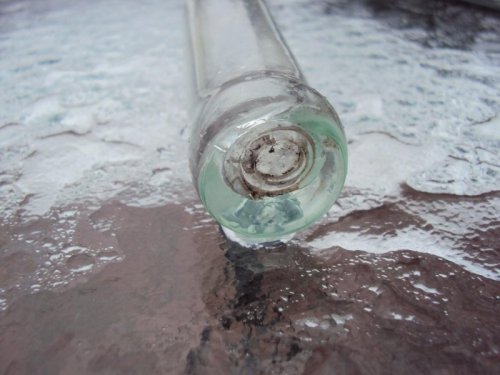Steve/sewell
Well-Known Member
- Joined
- Jan 23, 2010
- Messages
- 6,108
- Reaction score
- 5
- Points
- 0
Millville's first glass works were started in 1806 by James lee.Lee originally named the factory Glasstown.The original factory made window glass, and it later expanded to making bottles in 1809, presumably vials and junk bottle (common Farmer bottles). James was the son of Francis Lee who came from Belfast, Ireland, to Pennsylvania. In 1799 James Lee built a glass factory in Port Elizabeth New Jersey he called the Eagle Glass Works. He then left Port Elizabeth and established the factory here in Millville in 1806.
A gentleman from the early days describes Lee as a promoter who abandoned one newly established enterprise after another. Lucius Elmer describes Lee as "an active enterprising man, too spasmodic in his efforts to succeed well." By 1814 Lee sold his Millville factory to Gideon Scull. In 1814 he moved to Bridgeton and built a saw mill (originally planned to be a paper mill), a general store and a raceway from the new mill dam on the Cohansey river. In 1817 Lee and his family moved to Cincinnati after a short stay to Maysville, Kentucky. He died in New Orleans in 1824.
The bottle shown here was found on the site of James Lee's Glasstown glass works in 1984 by a backhoe operator friend of mine named Ed Fredricks.Ed was grading an area at the end of Buck Street near present day Rte. 49 behind the American Legion hall near the river for a future boat slip when a lot of broken glass cullet and other factory remnants were being found in large amounts.This bottle survived and is a very pretty pale aquamarine in color very typical of the sand from Cumberland county that to this day is some of the purest in the world.
A lot of the sand from here was shipped as far away as New England in the early 1800s.Ed has given me quite a few old bottles over the years as he is constantly digging foundations, swimming pools,sidewalks,driveways ect. I am very great full to Ed for all of the bottles I have received from him over the last thirty years.This bottle is very small for a vial standing just two and a half inches tall and three quarters of an inch in diameter.The walls of the glass are very thin but the flared lip is intact. I also have shards and cullet from the site I just cant seem to be able to locate them right now for this post.When I find them I will add them to this information.
In 1827, the company had three owners: Dr. George Burgin, Richard L. Wood, and Joel Bodine. Bodine left the company in 1829 and the company name changed to Burgin & Wood. With the addition of a new partner in 1833, the company?s name changed again to Burgin, Wood & Pearsall. At this time, the factory produced glass bottles using molds made out of clay.
Glasstown was purchased in 1836 by another company that changed the name to Scattergood, Booth, and Company. Following this transition of owners, Scattergood married a woman named Sarah Whitall. Sarah was the sister of Captain John Whitall, a major investor in the Glasstown factory. When Captain Whitall moved to Philadelphia with his new wife, Mary Tatum, he left the factory under his brother?s management. For the next three years, Captain Whitall?s brother, Israel Franklin Whitall, served as manager of the company .
By 1845 Scattergood no longer worked at Glasstown and the name was changed to Whitall, Brother, and Company.Israel Whitall became ill and ceased to work for the company after 1857 and a new partner a man named Edward Tatum became one of the owners. At this time, the company became Whitall Tatum and Company. The company quickly became very successful and additional space and buildings were needed and the company expanded northward up Buck street.. The company opened An office in New York and was managed by C.A. Tatum.
Whitall Tatum was one of the first glass factories to establish a laboratory. Here they tested different procedures and combinations of materials used in glass production . By 1899, business was booming and the Whitall Tatum Company had over four hundred employees at their Glasstown factory and over one thousand at their lower works division. As a result of their success, Millville, New Jersey became famous for glass working. I know the bottle could have come from anyone really over the last 175 years but it was found at the original glass works site and in an area which produced the same colored shards and broken tops like this one.This bottle also has a lean to one side.I wonder if it was a reject and sent to the cullet heap

A gentleman from the early days describes Lee as a promoter who abandoned one newly established enterprise after another. Lucius Elmer describes Lee as "an active enterprising man, too spasmodic in his efforts to succeed well." By 1814 Lee sold his Millville factory to Gideon Scull. In 1814 he moved to Bridgeton and built a saw mill (originally planned to be a paper mill), a general store and a raceway from the new mill dam on the Cohansey river. In 1817 Lee and his family moved to Cincinnati after a short stay to Maysville, Kentucky. He died in New Orleans in 1824.
The bottle shown here was found on the site of James Lee's Glasstown glass works in 1984 by a backhoe operator friend of mine named Ed Fredricks.Ed was grading an area at the end of Buck Street near present day Rte. 49 behind the American Legion hall near the river for a future boat slip when a lot of broken glass cullet and other factory remnants were being found in large amounts.This bottle survived and is a very pretty pale aquamarine in color very typical of the sand from Cumberland county that to this day is some of the purest in the world.
A lot of the sand from here was shipped as far away as New England in the early 1800s.Ed has given me quite a few old bottles over the years as he is constantly digging foundations, swimming pools,sidewalks,driveways ect. I am very great full to Ed for all of the bottles I have received from him over the last thirty years.This bottle is very small for a vial standing just two and a half inches tall and three quarters of an inch in diameter.The walls of the glass are very thin but the flared lip is intact. I also have shards and cullet from the site I just cant seem to be able to locate them right now for this post.When I find them I will add them to this information.
In 1827, the company had three owners: Dr. George Burgin, Richard L. Wood, and Joel Bodine. Bodine left the company in 1829 and the company name changed to Burgin & Wood. With the addition of a new partner in 1833, the company?s name changed again to Burgin, Wood & Pearsall. At this time, the factory produced glass bottles using molds made out of clay.
Glasstown was purchased in 1836 by another company that changed the name to Scattergood, Booth, and Company. Following this transition of owners, Scattergood married a woman named Sarah Whitall. Sarah was the sister of Captain John Whitall, a major investor in the Glasstown factory. When Captain Whitall moved to Philadelphia with his new wife, Mary Tatum, he left the factory under his brother?s management. For the next three years, Captain Whitall?s brother, Israel Franklin Whitall, served as manager of the company .
By 1845 Scattergood no longer worked at Glasstown and the name was changed to Whitall, Brother, and Company.Israel Whitall became ill and ceased to work for the company after 1857 and a new partner a man named Edward Tatum became one of the owners. At this time, the company became Whitall Tatum and Company. The company quickly became very successful and additional space and buildings were needed and the company expanded northward up Buck street.. The company opened An office in New York and was managed by C.A. Tatum.
Whitall Tatum was one of the first glass factories to establish a laboratory. Here they tested different procedures and combinations of materials used in glass production . By 1899, business was booming and the Whitall Tatum Company had over four hundred employees at their Glasstown factory and over one thousand at their lower works division. As a result of their success, Millville, New Jersey became famous for glass working. I know the bottle could have come from anyone really over the last 175 years but it was found at the original glass works site and in an area which produced the same colored shards and broken tops like this one.This bottle also has a lean to one side.I wonder if it was a reject and sent to the cullet heap






